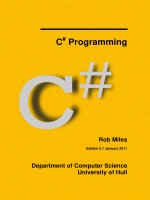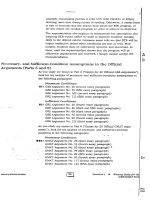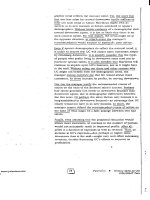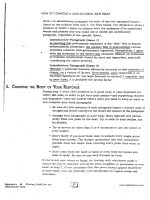Ebook ECG short rapid review for non-Cardiologists (edition 2.1): Part 2
Bạn đang xem bản rút gọn của tài liệu. Xem và tải ngay bản đầy đủ của tài liệu tại đây (3.8 MB, 73 trang )
CHAPTER 4 : VENTRICU LAR ARRYTHMIAS
IDIOVENTRICULAR RHYTHM
If the ventricle does not receive triggering signals , the
ventricular myocardium itself becomes the pacemaker
(escape rhythm). This is called Idioventricular Rhythm.
Ventricular signals are transmitted cell-to-cell between
cardiomyocytes and not by the conduction system,
creating wide sometimes bizarre QRS complexes(> 0.12
sec)
.
Rate : 20-40 bpm
Rhythm : Regular
P waves : None
PR interval : None
QRS : Wide (>0.10 sec) . Bizzare type appearance
Idioventricular rhythms occur when all of the heart’s
other pacemakers fail to function or when
supraventricular impulses can’t reach the ventricles
because of a block in the conduction system.
Ventricular arrhythmias originate in the ventricles below
the bundle of His and fires at the rate of 20-40 bpm .
Idioventricular rhytm may also be called as agonal
rhythm. If the rate is >40 bpm, it is called accelerated
idioventricular rhythm. The rate of 20-40 is the
61 | P a g e
"intrinsic automaticity" of the ventricular myocardium.
Bizzare appearance : The T wave and the QRS complex
deflect in opposite directions because of the difference in
the action potential during ventricular depolarization
and repolarization. P wave is absent because
depolarization of atria does not occur.
The arrhythmias may accompany third-degree heart
block or be caused by anything which damages AV node
like infarction or blocks it like digoxin.
ACCELETATED IDIOVENTRICULAR RHYTHM
Same as Idioventricular rhytm , only difference is , heart
rate. Here it’s 40-100 bpm , while in IVR it’s been 20-40
bpm
Rate : 40-100 bpm
Rhythm : Regular
P waves :None
PR interval :None
QRS : Wide (>10 sec) , Bizzare appearance
Idioventricular rhythms appear when supraventricular
pacing sites are depressed or absent. If the heart rate
62 | P a g e
become slow , diminished cardiac output is expected.
History is helpful for identifying the underlying etiology
for AIVR. Most patients with AIVR presents with chest
pain or shortness of breath (symptoms related to
myocardial ischemia with history of myocardial
reperfusion with drugs or coronary artery
interventions.) ,Plus Peripheral edema, cyanosis,
clubbing, (With the history of cardiomyopathy,
myocarditis, and congenital heart diseases )
Treatment : Idioventricular rhythm should never be
treated with lidocaine or other antiarrhythmics that
would suppress that safety mechanism.
If the symptoms develops , immediate treatment
required to increase his heart rate, improve cardiac
output and establish a normal rhythm. Treat the
Underlying Cause .
In life-threatening situations in which time is critical, a
transcutaneous pacemaker may be used to regulate
heart rate.
VENTRICULAR TACHYCARDIA (MONOMORPHIC)
Ventricular tachycardia refers to any rhythm faster than
100 beats per minute, with 3 or more irregular beats in a
row, arising distal to the bundle of His. In Monomorphic
type , The shape, size and amplitude of QRS complex will
be same
63 | P a g e
Rate : 100-250 bpm
Rhythm : Regular
P waves : None or not associated with the QRS
PR interval : None
QRS : Wide (>0.10sec) , Bizzare appearance
It is important for a physician to confirm the presence or
absence of pulses because monomorphic VT may be
perfusing or non perfusing. Sustained SVTs requiring
immediate treatment to prevent death, monomorphic VT
will probably deteriote into VF or unstable VT if
sustained and not treated.
Ventricular tachycardia usually results from increased
myocardial irritability, which may be triggered by
enhanced automaticity or reentry within the Purkinje
system or by PVCs.
Conditions that can cause ventricular tachycardia
include:
Myocardial ischemia & Infarction
Coronary artery disease
Valvular heart disease
Heart failure, Cardiomyopathy
Hypokalemia
Drugs like digoxin , procainamide, quinidine or
cocaine
64 | P a g e
VENTRICULAR TACHYCARDIA (POLYMORPHIC)
The difference between monomorphic and polymorphic
is the presence of different type of complexes in
polymorphic.
Rate : 100-250 bpm
Rhythm : Regular
P waves : None or not associated with the QRS
PR interval : None
QRS : Wide (>0.10sec) , Bizzare appearance
Electrolyte abnormality is a possible etiology behind this.
Patient in VT will present with Palpitation,
lightheadedness, and syncope (from diminished cerebral
perfusion). Chest pain (due to ischemia or to the rhythm
itself. Anxiety usually present. Some patients describe a
sensation of neck fullness, which may be related to
increased central venous pressure and cannon a waves.
“Cannon A” waves are related to right atrial contraction
against a closed tricuspid valve (Jugular Venous Pressure
Graph is Discussed later on) . Dyspnea (due to increased
pulmonary venous pressures when left atrial contraction
65 | P a g e
against a closed mitral valve). Ventricular Tachycardia
can convert into Ventricular Fibrillation if not treated . V.
fib is a medical emergency .
It is important to confirm the presence or absence of
pulses because polymorphic VT may be perfusing or non
perfusing.
Treatment of VT: They are Treated aggressively by Anti
arrythmimc drugs . Coronary revascularization is
indicated to reduce the risk of SCD in patients with VF
when there is presence of direct evidence of acute
myocardial ischemia . Amiodarone or lidocaine are
usually used.
VENTRICULAR FIBRILLATION
Is when ventricles fire rapidly and asynchronously at rate
more than 300.Most common cause of death in cardiac ER.
Massive hypoperfusion will occur throughout the body
Rate : 300-600
Rhythm : Extremely Irregular
P wave : Absent
PR interval : N/A
QRS : Fibrillatory baseline
66 | P a g e
Ventricular fibrillation is defined when Ventricles beat
>250bpm.
V-fib, is a pattern of electrical activity in the ventricles in
which electrical impulses arise from many different foci.
It produces no effective muscular contraction and no
cardiac output. Untreated ventricular fibrillation causes
most cases of sudden cardiac death in people outside of a
hospital.
The ventricular rate, P wave, PR interval, QRS complex, T
wave, and QT interval cannot be determined.
Patient will present with Prodrome of symptoms of chest
pain, fatigue, palpitations, and other nonspecific
complaints (50% patients visit in 4 week before death) ,
A history of Left Ventricular impairment (LV ejection
fraction < 30-35%) is the single greatest risk factor for
sudden death from VF.
Otherwise , symptoms depend upon the underlying
cause of V-Fib : Coronary artery Disease , Hypertrohpic
or dilated cardiomyopathy , valvular pathology ,
Myocarditis , Congenital Heart Disease (All this
pathology are discussed in Pathology Section)
Treatment : if pulseless , treat with immediate
defibrillation followed by epinephrine , vasopressin ,
amiodarone or lidocaine.
If pulse is present treat with amiodarone and
synchronized cardioversion.
67 | P a g e
TORSADE DE POINTES
Characterized by a gradual change in the amplitude and
twisting of the QRS complexes around the isoelectric line
Rate : 200-250 bpm
Rhythm : Irregular
P waves : None
PR interval : None
QRS : Wide (>0.10sec) , Bizzare appearance
The main causes of Torsades are Drugs that prolong QT
interval and electrolyte abnormalities such as
Hypomagnessemia.
This rhythm is unusual variant of polymorphic VT with
the normal or long QT intervals. It may deteriotes to
Ventricular fibrillation or asystole. Patient usually
present with recurrent episodes of palpitations,
dizziness, and syncope; however, sudden cardiac death
can occur with the first episode. Nausea, cold sweats,
shortness of breath, and chest pain also may occur but
are nonspecific and can be produced by any form of
tachyarrhythmia.
HALLMARK : QRS complexes that rotate about the
68 | P a g e
baseline, deflecting downward and upward for several
beats.
Treatment : Magnesium (Decreases the influx of calcium,
thus lowering the amplitude of Action Potentials ).
Beta-1 Agonist Drugs (to increase Heart rate and
decrease Prolonged QT interval).
If torsades convert into V-Fib – Direct Current
Cardioversion is required .
PULSELESS ELECTRICAL ACTIVITY
When you try to measure pulse ,you will not detect them
, but , when you will perform ECG , identifiable electrical
rhythms are produced.
Rate , Rhythm , P waves .PR interval ,QRS - All reflects
the underlying rhythm.
Rhythm may be sinus , atrial , juinctional , or ventricular
in origin. PEA is also called as electromechanical
dissociation .
69 | P a g e
In pulseless electrical activity, the heart muscle loses its
ability to contract even though electrical activity is
preserved. As a result, the patient goes into cardiac
arrest.
On an electrocardiogram, you’ll see evidence of
organized electrical activity, but you won’t be able to
palpate a pulse or measure the blood pressure.
This condition requires rapid identification and
treatment.
Causes include :
Hypovolemia , Hypoxia,
Acidosis, Tension pneumothorax,
Cardiac tamponade, massive pulmonary
embolism
Hypothermia, hyperkalemia,
Overdose of drugs such as tricyclic
antidepressants , calcium channel blockers ,
digoxin
Treatment : Cardiopulmonary resuscitation is the
immediate treatment, along with epinephrine. Atropine
may be given to patients with bradycardia. Subsequent
treatment focuses on identifying and correcting the
underlying cause.
70 | P a g e
ASYSTOLE
Electical activity in the ventricles is completely absent –
A straight line
Rate, Rhythm, P waves, PR interval, QRS : None
Always confirm asystole by checking the ECG in two
different leads . Also search to identify underlying
ventricular fibrillation.
This most commonly occur from a prolonged period of
cardiac arrest without effective resuscitation. Seek to
identify the underlying cause as in PEA.
The patient is in cardiopulmonary arrest. Without rapid
initiation of CPR (Cardio-pulmonary Resuscitation) and
appropriate treatment, the situation quickly becomes
irreversible
Anything that causes inadequate blood flow to the heart
may lead to asystole
The immediate treatment for asystole is CPR
71 | P a g e
CHAPTER 4 : HEART B L OCKS
ATRIOVENTRICULAR BLOCKS (FIRST DEGREE
BLOCK)
It is the prolongation of the PR interval on an
electrocardiogram (ECG) to more than 200 msec.
Rate : Depends on the underlying rhythm
Rhythm : Regular
P waves : Normal
PR interval : Prolonged (>0.20sec)
QRS : Normal
Usually AV block is benign , but if associated with an
acute MI. it may lead to futher AV defects.. Whenever
there is increase in PR interval , think about AV node
problem
First-degree AV block occurs when impulses from the
atria are consistently delayed during conduction through
the AV node. Conduction eventually occurs , it just takes
longer than normal. just the underlying cause will be
treated, not the conduction disturbance itself.
72 | P a g e
Patient is usually asymptomatic at REST . Markedly
prolonged PR interval may reduce exercise tolerance in
some patients with left ventricular systolic dysfunction.
Syncope may result from transient high-degree AV block,
especially in those with infranodal block and wide QRS
complex. Other symptoms might be present depending
upon the causes of AV Block.
Causes of AV block :
Temporary block : Myocardial infarction (MI), usually
inferior wall MI , Digoxin toxicity ,Calcium Channel and
Beta blockers , Cardiac surgery
Permanent block : Changes associated with aging ,
Congenital abnormalities , MI, usually anteroseptal MI ,
Cardiomyopathy , Cardiac surgery
Treatment :
Asymptomatics : No treatment ,
Symptomatics : If PR interval > 300 msec, Placement of a
dual-chamber pacemaker, medications (eg, atropine,
isoproterenol) can be used in anticipation of insertion of
a cardiac pacemaker.
Warning : Avoid B-blockers and CCBs (both slowers the
conduction)
73 | P a g e
2 N D DEGREE AV BLOCK : MOBITZ TYPE I
P-R interval becomes progressively longer and then one P
wave will be block , resulting in no QRS production. Note
that – P wave is formed .and later on normal cycle
continues.
Rate : Depends on the rate of underlying rhythm
Rhythm: Irregular
P waves : Normal
PR interval : Progressively become long until one P
wave is blocked and a QRS is dropped
QRS : Normal (Absent during block)
Ischemia involving right coronary artery is one potential
cause. Because RCA supplies AV node in 80% of Patients.
Hallmark : increasing PR interval with successive beat
and sudden drop and cycle repeats
Usually asymptomatic, a patient with type I seconddegree AV block may show signs and symptoms of
decreased cardiac output, such as light-headedness or
hypotension.
Symptoms may be especially pronounced if the
ventricular rate is slow.
74 | P a g e
Treatment :
For asymptomatics – No Rx
For symptomatics : Atropine may improve AV
node conduction
For long term relief : Temporary Pacemaker.
2 N D DEGREE AV BLOCK : MOBITZ TYPE II
Conduction ratio (P waves to QRS complexes) is
commonly 2:1 , 3:1, or 4:1
QRR complexes are usually wide because this block
usually involves bot right and left bundle branch block
Rate : Atrial rate (60-100bpm) , Faster than the
ventricular rate (because they are blocked)
Rhythm : Atrial regular, and ventricular : Irregular
P Waves : Normal , more P waves than QRS complexes
PR interval : Normal or prolonged but constant
QRS : Usually wide
Resulting Bradycardia can compromise cadiac output
and lead to complete AV block. This rhythm often
75 | P a g e
occurs with cardiac ischemia or an MI.
Occasional impulses from the SA node fail to conduct to
the ventricles so a drop beat will be seen
In 2:1 second-degree atrioventricular (AV) block, every
other QRS complex is dropped, so there are always two P
waves for every QRS complex.
In 3:1 – three P waves for every QRS complex. The
resulting ventricular rhythm is regular.
Patient is usually asymptomatic , but , as the number of
dropped beats increases, patients may experience
palpitations, fatigue, dyspnea, chest pain, or lightheadedness.
On physical examination, you may note hypotension, and
the pulse may be slow and regular or irregular.
Patient must be kept under frequent observation . if
symptoms develop
Aim in treatment use to be
Increase cardiac output by increasing heart rate
to prevent underperfusion of organs. Atropine,
dopamine, or epinephrine may be given for
symptomatic bradycardia
Pacemaker
Discontinue digoxin, if it’s the cause of the
arrhythmia
76 | P a g e
3 R D DEGREE AV BLOCK
Electrical block is at or below the AV node , and so ,
conduction between the atria and ventricle is absent. 3rd
degree heart block is also called as complete heart block
Rate : Atrial (60-100bpm) , Ventricular : 40-60 bpm if
escape focus is junctional , <40 bpm if escape focus is
ventricular
Rhythm : Usually regular , but atria and ventricles
contracts independently
P Waves : Normal , may be superimposed on QRS
complexes or T waves
PR interval : Varies greatly
QRS : Normal , if ventricles are activated by junctional
escape focus , wide if escape focus is ventricular
It is most commonly a congenital condition. This block
may also be caused by :
Coronary artery disease an anterior or inferior
wall MI, degenerative changes in the heart
Drugs like Digoxin toxicity, calcium channel
blockers, beta-adrenergic blockers, or surgical
injury
Patients are symptomatics, symptoms include severe
fatigue, dyspnea, chest pain, lightheadedness, changes in
mental status, and loss of consciousness.
You may note hypotension, pallor, diaphoresis,
77 | P a g e
bradycardia, and a variation in the intensity of the pulse.
Therapy aims to improve the ventricular rate.
Treatment : Atropine , Dopamine , Epinephrine,
temporary pacing. For permanent block requires
permanent pacemaker.
SINOATRIAL BLOCK (SA BLOCK)
There is drop of beat , but , after beat drop , cycle
continues with normal rate and rhythm.
Rate : Normal to slow , depends upon the duration and
frequency of SA block
Rhythm : Irregular whenever SA blocks occur , Regular
after that
P waves : Absent during drop beat, but once cycle
continues it will be normal
PR interval : Depends upon the duration of drop beat ,
afterward , it will be normal
QRS : Depends upon the duration of drop beat ,
afterward , it will be normal
Cardiac output can decrease during drop beat . usually
asymptomatic , but if last longer , syncope or dizziness
78 | P a g e
can occur. SA Blocks must not be confuse with – A)
Mobitz type l AV Block (discussed next) where there is
prolongation of PR intervation with every successive
beat and then beat is dropped. B) P waves are present ,
ventricular beat is dropped. Here , PR interval remains
same after all beats and problem is with SA node.
Patients are usually asymptomatics , while In some
people they can cause fainting, altered mental status,
chest pain, hypoperfusion, and signs of shock.
Treatment : Not required for asymptomatics , but in
emergent situation use Atropine or Transuctaneous
Pacing .
RIGHT & LEFT BUNDLE BRANCH BLOCKS
Notches in the QRS complex are classics of BBB
Rate : Depends upon the rate of underlying rhythm
Rhythm : Regular
P Waves : Normal
PR interval : Normal
QRS : Usually wide (>0.10 sec) with a notched
appearance
79 | P a g e
Commonly , BBB occur in Coronary artery Disease
Potential complication of an Myocardial Infarction is a
bundle-branch block
Right bundle-branch block
RBBB occurs with such conditions as anterior wall MI,
CAD, cardiomyopathy, cor pulmonale, and pulmonary
embolism
Left bundle-branch block
Left bundle-branch block (LBBB) never occurs normally.
This block is usually caused by hypertensive heart
disease, aortic stenosis, degenerative changes of the
conduction system, or Coronary artery disease.
Left anterior fascicular block is a cardiac condition
distinguished from left bundle branch block. It is caused
by only the anterior half of the left bundle branch being
80 | P a g e
defective. It is manifest on the ECG by left axis
deviation.
It is the most common type of intraventricular
conduction defect seen in acute anterior
myocardial infarction, and the left anterior
descending artery is usually the culprit vessel.
It can be seen with acute inferior wall
myocardial infarction.
It also associated with hypertensive heart
disease, aortic valvular disease,
cardiomyopathies, and degenerative fibrotic
disease of the cardiac skeleton.
Left posterior fascicular block (LPFB) is a condition
where the left posterior fascicle, i.e. the backside part of
the left cardiac bundle, does not conduct the electrical
impulses from the atrioventricular node. The electricity
then has to go through the other fascicle, and thus is a
frontal right axis deviation seen on the ECG.
BBB are usually normal , even some people are born with
this , but , in Some people it describes the underlying
defect (Causes mentioned above).
Treatment is not required for asymptomatics , Treat
according to the underlying cause . In severe Cases
Pacemaker might be required.
81 | P a g e
CHAPTER 5 : MYOCARD IAL INFARCTION
Acute myocardial infarction : Pain is the most common
presenting symptom in patients with AMI. The pain is
typically felt substernally or in the epigastrium. It’s often
described as – Crushing or Stabbing or Burning pain .
Pain may also irradiate to left arm and/or jaw (because
the sympathetic fibres from T1-T2 will supply both heart
and left arm, jaw) , sudden onset of shortness of breath ,
fatigue or adrenergic symptoms .
Pain is not controlled by Nitroglycerin.
Serum Cardiac markers will be released into the blood
due to Cell lysis/death . Markers will not be present in
blood if myocardiocyte does not die (example : in Angina
Pectoralis)
Troponin I (Specific marker)- Rises by first 4
hours and remain elevated for 7-10 days.(usually
drawn every 8 hours three times till MI is ruled
out)
Creatine Kinase-MB peaks about 20 hours after
AMI.
LDH (Lactate dehydrogenase) is marker of
reinfarction within 7 days.
On ECG , Total occlusion of artery will result in ST
elevation (depression means ischemia , elevation means
injury) .
In Subtotal occlusion or transient occlusion , there will
be adequate collateral circulation , then ST segment
elevation does not occur. Most patients who present with
ST segment elevation , eventually develop Q wave on
82 | P a g e
ECG (which will indicate as a marker of previous MI)
Causes of MI :
Ischemic
Angina, reinfarction, infarct extension
Heart failure, cardiogenic shock, mitral
Mechanical valve dysfunction, aneurysms, cardiac
Rupture
Atrial or ventricular arrhythmias, sinus or
Arrhythmic atrioventricular node dysfunction
Embolic
Central nervous system or peripheral
embolization
Inflammatory Pericarditis
Differentials for MI : Gastroesophageal reflux disease &
Peptic ulcer disease (pain related to certain food ,
relieved by antacids) , Stable angina (Pain on exertion ,
ST segment depression) , Unstable angina (pain at rest,
ST segment depression ) , Esophageal problems ,
Pericarditis (Diffuse ST-segment elevation) , Pleuritis,
Prinzmental angina (pain at rest, ST ELEVATION)
Post MI Complications :
Cardiac arrest : This most commonly occurs due to
patients developing ventricular fibrillation and is the
most common cause of death following a MI. Patients are
managed with defibrillation.
Cardiogenic shock : If a large part of the ventricular
myocardium is damaged in the infarction the ejection
fraction of the heart may decrease to the point that the
83 | P a g e
patient develops cardiogenic shock. This is difficult to
treat. Other causes of cardiogenic shock include the
'mechanical' complications such as left ventricular free
wall rupture as listed below. Patients may require
inotropic support and/or an intra-aortic balloon pump.
Chronic heart failure: As described above, if the patient
survives the acute phase their ventricular myocardium
may be dysfunctional resulting in chronic heart failure.
Loop diuretics such as furosemide will decrease fluid
overload. Both ACE-inhibitors and beta-blockers have
been shown to improve the long-term prognosis of
patients with chronic heart failure.
Tachyarrhythmias : Ventricular fibrillation, as
mentioned above, is the most common cause of death
following a MI. Other common arrhythmias including
ventricular tachycardia.
Bradyarrhythmias : Atrioventricular block is more
common following inferior myocardial infarctions.
Pericarditis : Pericarditis in the first 48 hours following
a transmural MI is common (c. 10% of patients). The
pain is typical for pericarditis (worse on lying flat etc), a
pericardial rub may be heard and a pericardial effusion
may be demonstrated with an echocardiogram.
Dressler's syndrome tends to occur around 2-6 weeks
following a MI. The underlying pathophysiology is
thought to be an autoimmune reaction against antigenic
proteins formed as the myocardium recovers. It is
84 | P a g e
characterised by a combination of fever, pleuritic pain,
pericardial effusion and a raised ESR. It is treated with
NSAIDs.
Left ventricular aneurysm : The ischemic damage
sustained may weaken the myocardium resulting in
aneurysm formation. This is typically associated with
persistent ST elevation and left ventricular failure.
Thrombus may form within the aneurysm increasing the
risk of stroke. Patients are therefore anticoagulated.
Left ventricular free wall rupture : This is seen in
around 3% of MIs and occurs around 1-2 weeks
afterwards. Patients present with acute heart failure
secondary to cardiac tamponade (raised JVP, pulsus
paradoxus, diminished heart sounds). Urgent
pericardiocentesis and thoracotomy are required.
Ventricular septal defect : Rupture of the
interventricular septum usually occurs in the first week
and is seen in around 1-2% of patients. Features: acute
heart failure associated with a pan-systolic murmur. An
echocardiogram is diagnostic and will exclude acute
mitral regurgitation which presents in a similar fashion.
Urgent surgical correction is needed.
Acute mitral regurgitation : More common with inferoposterior infarction and may be due to ischemia or
rupture of the papillary muscle. An early-to-mid systolic
murmur is typically heard. Patients are treated with
vasodilator therapy but often require emergency surgical
repair.
85 | P a g e









